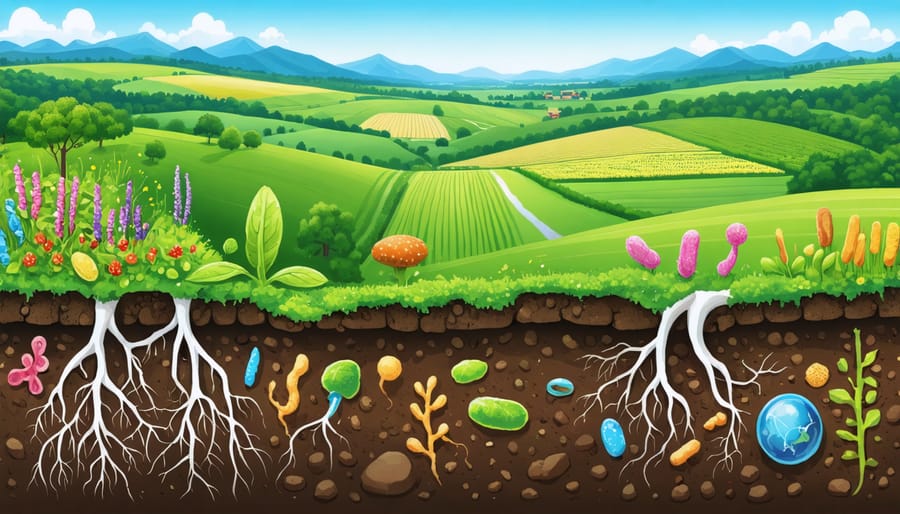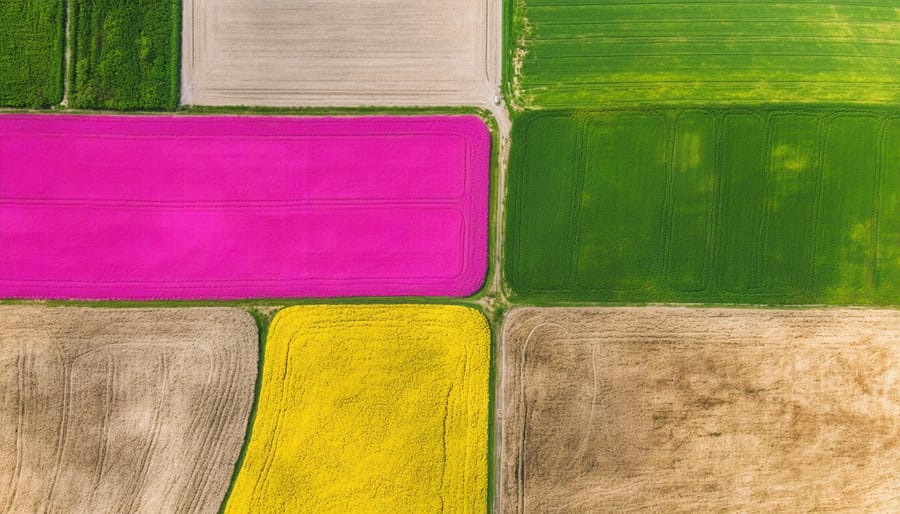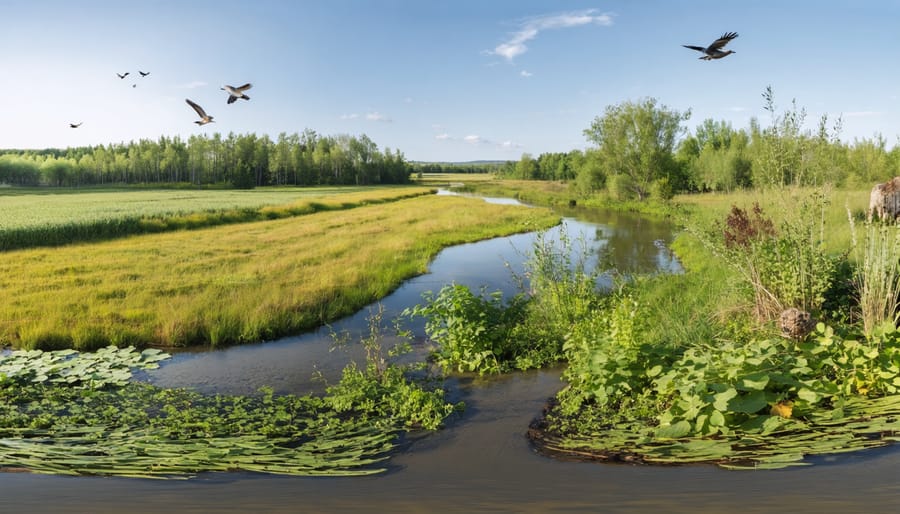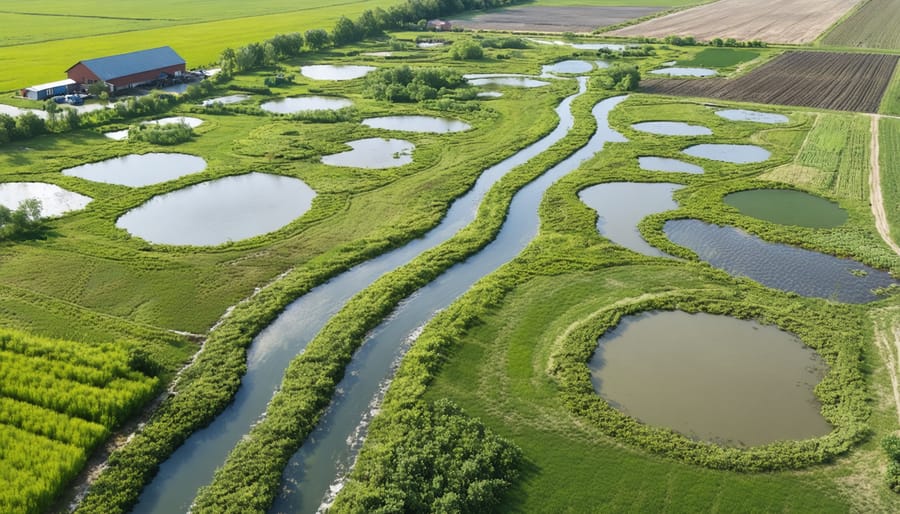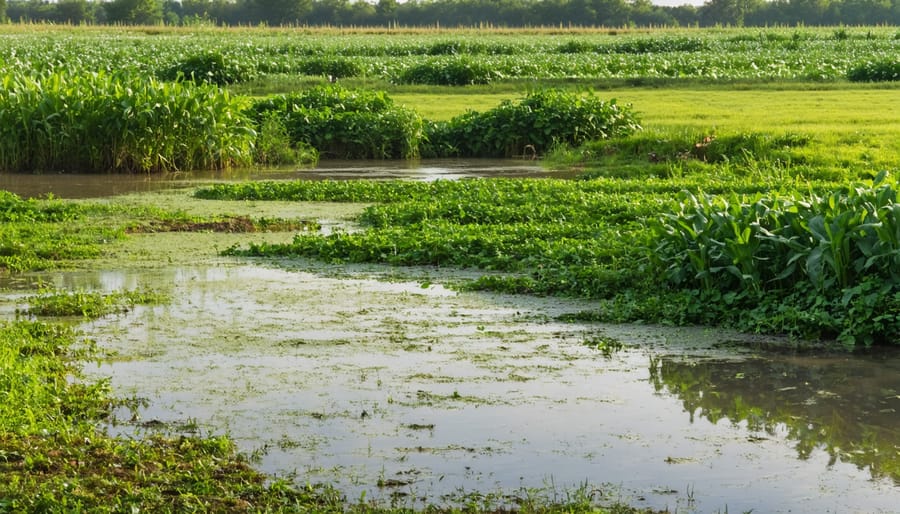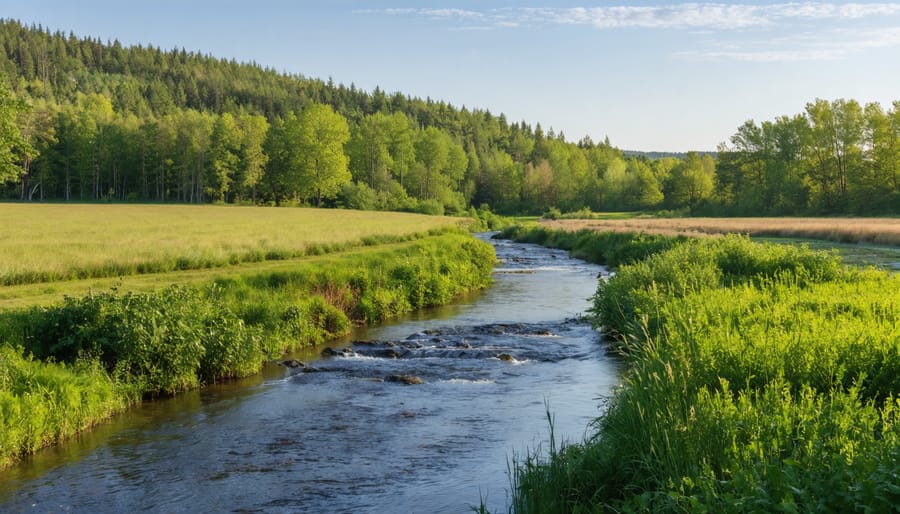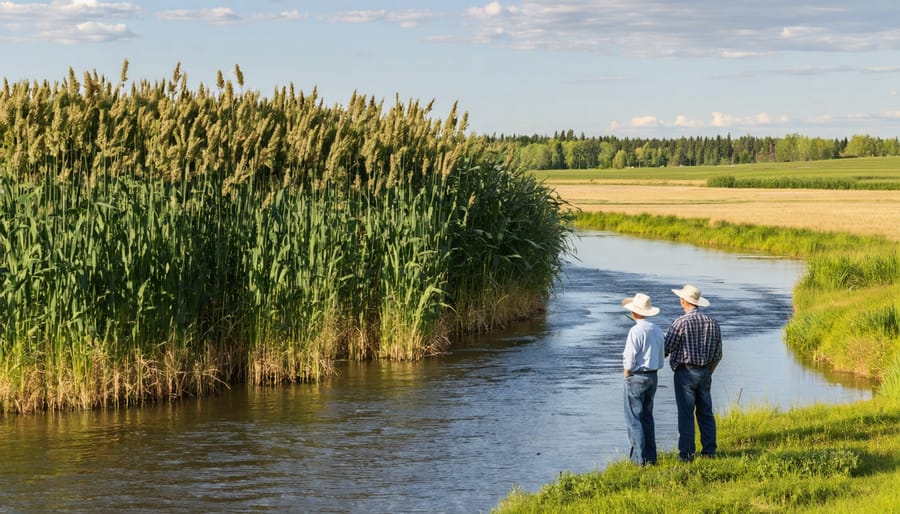Beneath every successful crop lies a thriving microscopic universe that powers Canadian agriculture. The soil microbiome—a complex network of bacteria, fungi, and other microorganisms—fundamentally drives nutrient cycling, disease suppression, and biodiversity in agricultural systems. For Alberta farmers, understanding this invisible workforce means the difference between average yields and exceptional harvests.
Recent research from Prairie soil labs shows that a single teaspoon of healthy soil contains more microorganisms than there are people on Earth. These microscopic allies transform organic matter into plant-available nutrients, create soil structure that resists erosion, and form natural defense systems against crop pathogens. By working with—rather than against—these soil communities, Canadian farmers are discovering sustainable paths to increased productivity without relying heavily on synthetic inputs.
The key to agricultural resilience lies not just in what we see above ground, but in the complex relationships happening beneath our feet. As we face increasingly unpredictable growing seasons, healthy soil microbiomes offer a proven strategy for building more resilient farming operations across the Canadian Prairies.
The Living Laboratory Beneath Your Feet
Meet Your Microscopic Farmhands
Think of your soil as a bustling underground city where billions of tiny workers contribute to soil ecosystem resilience. These microscopic farmhands fall into several key groups, each with their own specialized role.
Bacteria are your primary decomposers, breaking down organic matter and releasing nutrients your crops need. In just one gram of healthy Alberta soil, you’ll find millions of these helpful bacteria. Right alongside them, fungi form vast networks that transport nutrients and water through your soil, acting like nature’s delivery system.
Protozoa and nematodes might be small, but they’re mighty regulators of bacterial and fungal populations. They help maintain the perfect balance in your soil community. Meanwhile, actinomycetes give soil that fresh, earthy smell while helping to break down tough organic materials like cellulose and lignin.
These microorganisms work together, creating a healthy soil food web that supports your crops. When you support these tiny workers, they’ll support your farm’s productivity in return, improving everything from nutrient availability to soil structure.
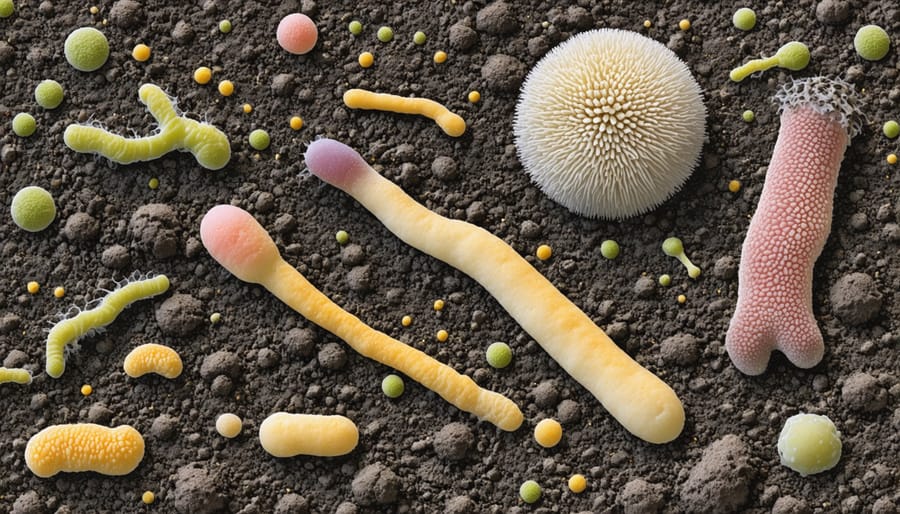
The Prairie Advantage: Alberta’s Native Soil Life
Alberta’s native prairie soils harbor some of the most diverse and resilient microbiome communities in North America, thanks to centuries of natural grassland evolution. These soils typically contain up to 100 million microorganisms per gram, including beneficial bacteria, fungi, and protozoa that have adapted specifically to our regional climate and soil conditions.
Our prairie soil microbiomes are particularly rich in mycorrhizal fungi, which form extensive networks supporting healthy root systems and efficient nutrient cycling. These indigenous microorganisms have developed remarkable strategies to cope with our distinct seasonal changes and varying moisture levels, making them invaluable partners in sustainable agriculture.
Local farmers who maintain these native soil communities often report stronger drought resistance, better nutrient retention, and improved crop yields. The natural balance of our prairie soil life also helps suppress common crop diseases and reduces the need for synthetic inputs. Understanding and working with these native microbiomes can give Alberta farmers a significant advantage in both conventional and organic farming systems.
For best results, agricultural practices that minimize soil disturbance and maintain organic matter levels help preserve these beneficial microbial communities that have evolved in our unique prairie ecosystem.
Your Soil’s Support System at Work
Nature’s Nutrient Cycle
The remarkable process of nutrient cycling in soil is like a well-orchestrated dance, where microorganisms play the leading role. These tiny powerhouses break down organic matter – everything from fallen leaves to crop residues – into forms that plants can readily use. Much like traditional soil management practices have long recognized, this natural recycling system is essential for maintaining soil fertility.
In Alberta’s agricultural lands, bacteria and fungi work tirelessly to decompose complex organic compounds into simpler nutrients. For example, when these microbes break down plant material, they release nitrogen in the form of ammonium and nitrate, phosphorus as phosphate, and various other essential minerals that crops need to thrive.
This process isn’t just about breaking things down – it’s also about building them up. Microorganisms help create stable organic matter, or humus, which improves soil structure and water retention. They also form partnerships with plant roots, helping them access nutrients that would otherwise be locked away in the soil.
The speed and efficiency of this nutrient cycling depend on several factors that we can manage: soil moisture, temperature, and organic matter content. By maintaining optimal conditions through practices like reduced tillage and proper moisture management, we can support these beneficial microbes in their essential work.
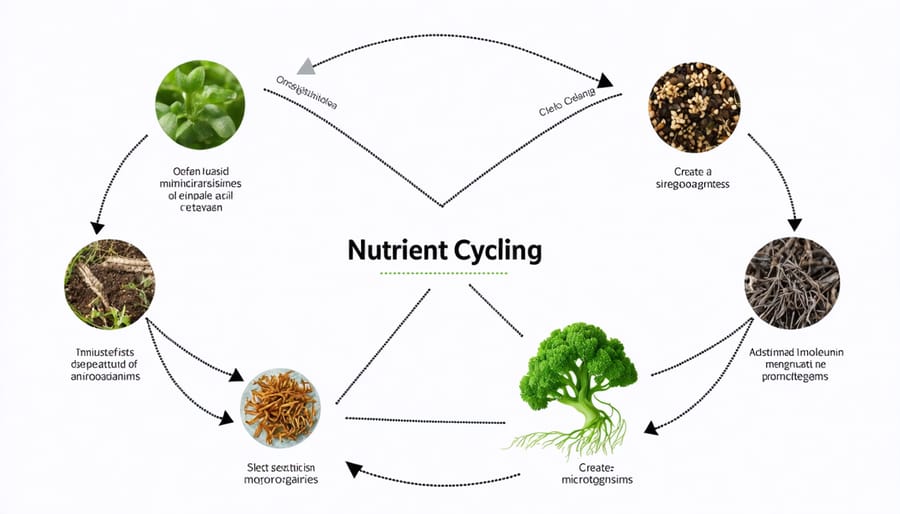
Disease Protection From the Ground Up
In the complex world beneath our feet, beneficial microbes serve as nature’s first line of defense against plant diseases. These microscopic allies work tirelessly to protect crops through various mechanisms that Canadian farmers can harness for better yields.
Studies at the University of Alberta have shown that healthy soil microbiomes create what scientists call “disease-suppressive soils.” These soils naturally prevent or reduce plant diseases through competitive exclusion, where beneficial microbes outcompete harmful pathogens for resources and space.
For example, in southern Alberta’s wheat fields, certain bacteria produce antibiotics that specifically target common root diseases. These microscopic defenders form protective barriers around plant roots, much like a shield, preventing harmful organisms from gaining a foothold.
Mycorrhizal fungi, another crucial component of the soil microbiome, form networks that not only help plants access nutrients but also strengthen their immune systems. When these fungi colonize root systems, they trigger the plant’s natural defense mechanisms, making crops more resilient to various diseases.
To support these beneficial microbes, many Alberta farmers are adopting practices like reducing tillage, maintaining crop diversity, and incorporating cover crops. These methods create stable environments where protective microorganisms can thrive and multiply, providing long-term disease protection that reduces the need for chemical interventions.
Remember, a thriving soil microbiome is your crop’s immune system – the healthier it is, the stronger your plants’ natural defenses will be.
Building Better Soil Structure
Healthy soil structure doesn’t just happen by chance – it’s the result of countless microscopic workers building and maintaining your soil’s architecture. These beneficial microorganisms act like natural engineers, producing sticky substances called polysaccharides and glomalin that bind soil particles together into stable aggregates.
Here in Alberta, where our soils face challenges from wind erosion and intense weather patterns, these microbial-formed aggregates are particularly valuable. They create a network of differently sized pores that help soil hold both water and air – essential for crop root development and nutrient uptake.
Local farmer Mike Thompson from Lacombe County has seen the benefits firsthand: “Since implementing practices that support soil microbes, my fields handle both drought and heavy rains better. The soil just has better structure and tilth.”
Bacteria and fungi work together to improve soil structure in different ways. Bacteria coat soil particles with their biofilms, while fungal hyphae physically wrap around particles, creating lasting bonds. This teamwork results in soil that’s more resistant to erosion and compaction.
To support these structural engineers in your soil:
– Minimize tillage to protect fungal networks
– Keep soil covered with residue or cover crops
– Maintain consistent moisture levels
– Add organic matter through composting or manure
– Reduce chemical inputs that might harm beneficial microbes
These practices help create a stable environment where soil microorganisms can thrive and continue their vital work of building better soil structure.
Practical Steps to Boost Your Soil’s Microbial Health
Smart Crop Rotation Strategies
A well-planned crop rotation strategy is one of your most powerful tools for fostering a diverse and healthy soil microbiome. Here in Alberta, successful farmers are finding that three to four-year rotation cycles provide optimal results for both soil health and crop yields.
Start by including nitrogen-fixing legumes like peas, lentils, or faba beans in your rotation. These crops form beneficial partnerships with rhizobia bacteria, naturally enriching your soil with nitrogen while supporting other beneficial microorganisms. Following legumes with heavy feeders like canola or wheat maximizes the benefits of this enhanced soil biology.
Consider including cover crops like clover or rye between main growing seasons. These plants maintain active root systems that feed soil microbes year-round and prevent beneficial bacterial populations from declining during fallow periods.
Deep-rooted crops like alfalfa help break up compacted soil layers while creating new channels for microbial movement. Alternating between shallow and deep-rooted plants ensures different soil layers remain biologically active.
Many Alberta farmers are finding success with diversity-focused rotations that include:
– Year 1: Legumes (peas/lentils)
– Year 2: Cereals (wheat/barley)
– Year 3: Oilseeds (canola/flax)
– Year 4: Cover crop/green manure
Remember to adjust your rotation plan based on your specific soil conditions, local climate, and market demands while maintaining the core principle of promoting microbial diversity.
Cover Crops: Your Microbes’ Best Friend
Cover crops are the unsung heroes of soil health, acting as a living blanket that nurtures and protects your soil’s microbial communities. Like organic farming methods, implementing cover crops creates an ideal environment for beneficial microorganisms to thrive.
For Alberta farmers, cold-hardy options like fall rye, winter wheat, and hairy vetch work exceptionally well between growing seasons. These crops create a dense root network that provides both habitat and food for soil microbes throughout winter months. During the spring thaw, their decomposition releases a steady stream of nutrients that feeds your soil’s microscopic workforce.
The key to maximizing microbial benefits lies in diversity. Consider mixing cereals with legumes – for instance, combining fall rye with field peas. This approach supports different microbial groups: while legumes foster nitrogen-fixing bacteria, cereals promote beneficial fungi that extend your soil’s nutrient network.
Timing your cover crop termination is crucial for microbial health. Rather than complete removal, consider rolling or crimping your cover crops to create a natural mulch layer. This practice, popular among successful Prairie farmers, maintains soil moisture and provides a steady food source for microorganisms.
For best results, aim to keep living roots in your soil for as many months as possible. Even short-duration cover crops between main growing seasons can significantly boost microbial activity. Remember, every day your soil hosts active root systems is another day your microscopic allies are working to improve your soil’s structure and fertility.
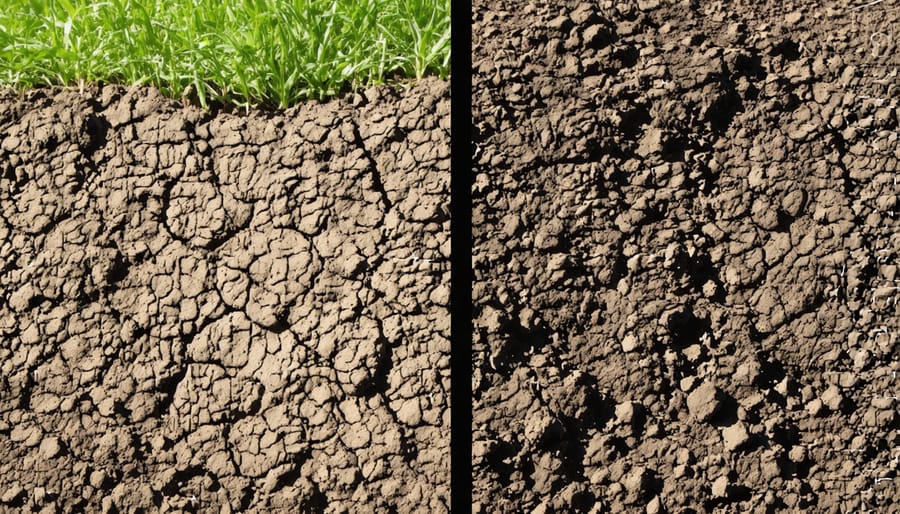
Minimal Tillage, Maximum Life
Every pass of the plow disrupts millions of microscopic lives in your soil, which is why more Alberta farmers are embracing minimal tillage practices. When we reduce soil disturbance, we protect the intricate networks of beneficial fungi, bacteria, and other microorganisms that make our soil naturally productive.
Take the experience of Dave Thompson, a third-generation farmer near Red Deer, who saw his soil organic matter increase by 2% over five years after switching to minimal tillage. “The soil just holds together better now,” he notes. “Even in dry spells, my crops seem more resilient.”
Minimal tillage works by leaving crop residue on the surface, creating a natural blanket that protects soil microbes. This organic layer moderates soil temperature, preserves moisture, and provides food for beneficial organisms. Research from the University of Alberta shows that undisturbed soil can host up to 1,000 times more beneficial fungi than heavily tilled fields.
The transition doesn’t have to happen overnight. Many successful farmers start with reduced tillage on a portion of their land, often beginning with their most erosion-prone fields. Equipment modifications, like using low-disturbance openers on seeders, can help maintain optimal seed placement while minimizing soil disruption.
The financial benefits are compelling too. Reduced fuel costs, lower equipment wear, and improved moisture retention often offset any initial challenges. Plus, as soil health improves, many farmers report using less fertilizer while maintaining yields.
Remember, every time you choose not to till, you’re giving your soil microbiome a chance to thrive and work for you.
The health of our soil microbiomes is fundamental to the success of Canadian agriculture, and each of us has the power to make positive changes on our farms. By understanding the complex relationships between soil microorganisms, plants, and farming practices, we can work with nature rather than against it.
Throughout Alberta and across Canada, farmers who have embraced microbiome-friendly practices are seeing remarkable results – from improved crop yields to better drought resistance and reduced input costs. These success stories show that small changes in our approach can lead to significant benefits for both our land and our bottom line.
Remember that building healthy soil microbiomes is a journey, not a destination. Start with simple steps like reducing tillage, implementing crop rotation, or introducing cover crops. Monitor your soil’s progress through regular testing and observation. Share your experiences with fellow farmers and learn from their successes and challenges.
The future of Canadian agriculture depends on our ability to work in harmony with these microscopic allies. By protecting and nurturing our soil microbiomes, we’re not just improving our farms – we’re contributing to a more sustainable agricultural future for generations to come.
Take action today: choose one microbiome-friendly practice to implement this season. Your soil’s billions of beneficial organisms will thank you, and your farm will be better for it.

